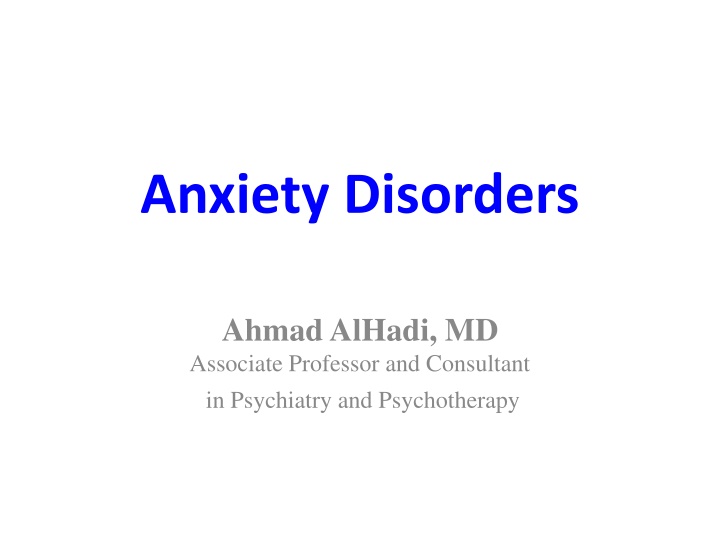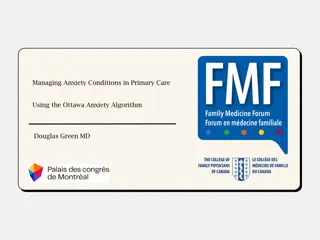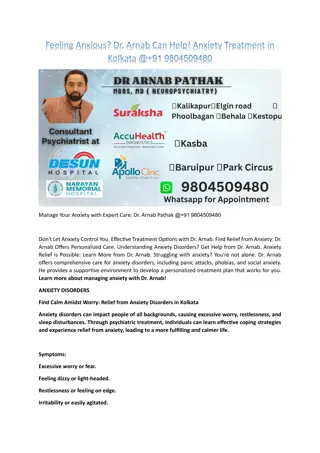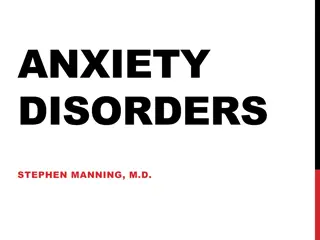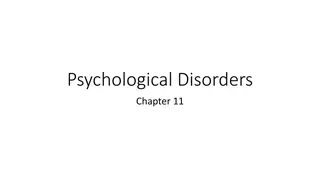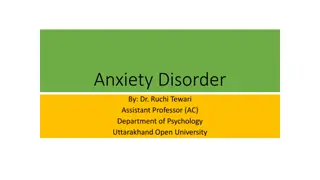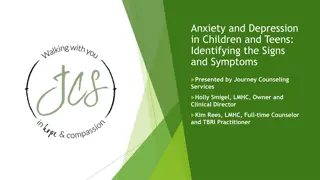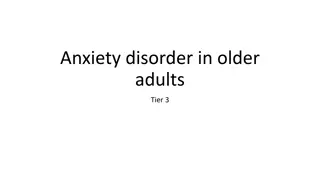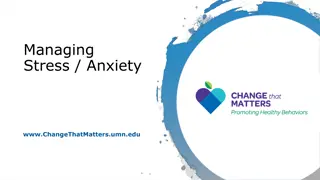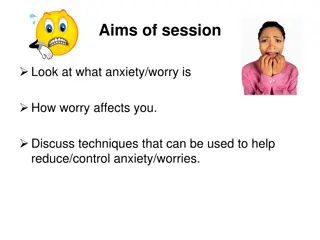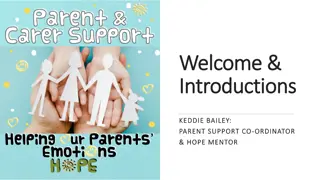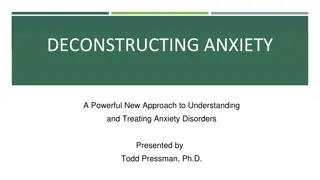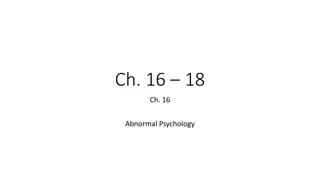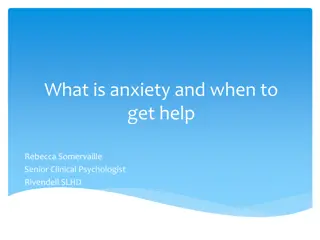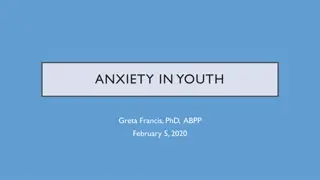Anxiety Disorders: Symptoms and Treatment
Anxiety disorders encompass a range of conditions, from panic disorder to social anxiety. Explore the diagnostic criteria, prevalence, causes, and treatment plans for these disorders. Dive into case vignettes like Layla's to understand the impact of anxiety on individuals' lives.
Download Presentation

Please find below an Image/Link to download the presentation.
The content on the website is provided AS IS for your information and personal use only. It may not be sold, licensed, or shared on other websites without obtaining consent from the author.If you encounter any issues during the download, it is possible that the publisher has removed the file from their server.
You are allowed to download the files provided on this website for personal or commercial use, subject to the condition that they are used lawfully. All files are the property of their respective owners.
The content on the website is provided AS IS for your information and personal use only. It may not be sold, licensed, or shared on other websites without obtaining consent from the author.
E N D
Presentation Transcript
Anxiety Disorders Ahmad AlHadi, MD Associate Professor and Consultant in Psychiatry and Psychotherapy
Objectives: List the diagnostic criteria for anxiety disorders according to DSM5. Discuss the prevalence and causes of Anxiety disorders. Discuss the treatment plan.
Introduction Case Hx MSE Types of Anxiety
Anxiety Disorders DSM-IV-TR 1. Panic Disorder 2. Agoraphobia 3. Specific Phobia 4. Social Phobia (Social Anx Dis). 5. Obsessive Compulsive Disorder (OCD) 6. Post Traumatic Stress Disorder (PTSD), Acute Stress Disorder 7. Generalized Anxiety Disorder (GAD)
Anxiety Disorders in DSM5 Obsessive-Compulsive and Related Disorder Trauma- and Stressor-Related Disorders Anxiety Disorders Separation Anxiety Disorder Selective Mutism Specific Phobia Social Anxiety Disorder Panic Disorder Agoraphobia Generalized Anxiety Disorder Substance/Medication- Induced Anxiety Disorder Anxiety Disorder Due to Another Medical Condition Obsessive-Compulsive Disorder Body Dysmorphic Disorder Hoarding Disorder Trichotillomania (Hair- Pulling Disorder) Excoriation (Skin-Picking) Disorder Substance/Medication- Induced Obsessive- Compulsive and Related Disorder Obsessive-Compulsive and Related Disorder Due to Another Medical Condition Reactive Attachment Disorder Disinhibited Social Engagement Disorder Posttraumatic Stress Disorder Acute Stress Disorder Adjustment Disorders
Case Vignette: Layla is 31 year old female. She came to your clinic complaining of fearfulness, palpitations, shortness of breath and impaired concentration. She is afraid that she will die. These symptoms come suddenly in episodes for the last two months.
Case Vignette: Layla is 31 year old female. She came to your clinic complaining of fearfulness, palpitations, shortness of breath and impaired concentration. She is afraid that she will die. These symptoms come suddenly in episodes for the last two months.
Features of Anxiety Psychological Physical Neuro: Excessive worries + anticipation ENT: Fear CVS & CHEST: Apprehension + hypervigilance GI: Difficulty concentrating Genito-urin.: Feeling of restlessness SKIN: Sensitivity to noise MSS: Sleep disturbance
Anxiety Disorders 1. Panic Disorder 2. Agoraphobia 3. Specific Phobia 4. Social Phobia. 5. Generalized Anxiety Disorder (GAD) 6. Obsessive Compulsive Disorder (OCD) 7. Post Traumatic Stress Disorder (PTSD), Acute Stress Disorder
Panic Disorder Panic attack : Panic Disorder: Disorder with specific criteria: 1- unexpected recurrent panic attacks (+/- situationally bound). a symptom not a disorder. Episodic sudden intense fear (of dying, going mad, or loosing self-control). Can be part of many disorders: panic disorder, GAD, phobias, sub. Abuse, acute & PTSD. 2- one month period (or more) of persistent concerns about another attack or implications of the attack or changes in behavior. 2 types: 1- unexpected. 2- situationally bound. 3- Not due to other disorders
Panic Attacks Situationally bound Unexpected - Anticipation Or immediately on exposure to the trigger Spontaneous. Essential to diagnose e.g. specific phobia. - can be ass./with Panic Disorder panic disorder
Panic Disorder Diagnostic Criteria 300.01 (F41.0) A. Recurrent unexpected panic attacks. A panic attack is an abrupt surge of intense fear or intense discomfort that reaches a peak within minutes, and during which time four (or more) of the following symptoms occur; Note: The abrupt surge can occur from a calm state or an anxious state. 1. Palpitations, pounding heart, or accelerated heart rate. 2. Sweating. 3. Trembling or shaking. 4. Sensations of shortness of breath or smothering. 5. Feelings of choking. 6. Chest pain or discomfort.
Panic Disorder Diagnostic Criteria 300.01 (F41.0) 7. Nausea or abdominal distress. 8. Feeling dizzy, unsteady, light-headed, or faint. 9. Chills or heat sensations. 10. Paresthesias (numbness or tingling sensations). 11. Derealization (feelings of unreality) or depersonalization (being detached from oneself). 12. Fear of losing control or going crazy. 13. Fear of dying. Note: Culture-specific symptoms (e.g., tinnitus, neck soreness, headache, uncontrollable screaming or crying) may be seen. Such symptoms should not count as one of the four required symptoms.
Panic Disorder Diagnostic Criteria 300.01 (F41.0) B. At least one of the attacks has been followed by 1 month (or more) of one or both of the following: 1. Persistent concern or worry about additional panic attacks or their consequences (e.g., losing control, having a heart attack, going crazy ). 2. A significant maladaptive change in behavior related to the attacks (e.g., behaviors designed to avoid having panic attacks, such as avoidance of exercise or unfamiliar situations).
Panic Disorder Diagnostic Criteria 300.01 (F41.0) C. The disturbance is not attributable to the physiological effects of a substance (e.g., a drug of abuse, a medication) or another medical condition (e.g., hyperthyroidism, cardiopulmonary disorders). D. The disturbance is not better explained by another mental disorder (e.g., the panic attacks do not occur only in response to feared social situations, as in social anxiety disorder: in response to circumscribed phobic objects or situations, as in specific phobia: in response to obsessions, as in obsessive- compulsive disorder: in response to reminders of traumatic events, as in posttraumatic stress disorder: or in response to separation from attachment figures, as in separation anxiety disorder).
Etiology Epidemiology Genetic predisposition Disturbance of neurotransmitters NE & 5 HT in the locus ceruleus (alarm system in the brain ) Behavioral conditioning Women > men Prevalence : 1 3 % Age at onset : 20 --- 35 years
Course & Prognosis With treatment : good Management Rule out physical causes. Support & reassurance Bio-Psycho-Social Medications: SSRIs / SNRIs TCAs BNZ CBT Social Some pts recover within weeks even with no treatment. Others have chronic fluctuating course.
Any Qs So far? PHOBIA S
Case Development 1: Layla started to be fearful whenever she leaves her home and ask for company all the time. She anticipated these episodes. 10 years ago, when she was in the university, she developed same episodes only in social situations like parties and presentations. She also has irrational fear from injections and she has the same episodes when she is exposed to them.
Anxiety Disorders 1. Panic Disorder 2. Agoraphobia 3. Specific Phobia 4. Social Phobia. 5. Generalized Anxiety Disorder (GAD) 6. Obsessive Compulsive Disorder (OCD) 7. Post Traumatic Stress Disorder (PTSD), Acute Stress Disorder
Phobia FEAR Avoidance panic attack endured with +++ discomfort
Phobic Disorders panic attack on exposure + avoidance or endured with +++ discomfort Irrational excessive fear Specific Agoraphobia Social Objects or situations: blood ex. dental clinic hospital airplane (height) animals insects thunder storms closed spaces/lifts darkness clowns Embarrassment when observed performing badly or showing anxiety features. where it is difficult or embarrassing to escape or get help. 1) Away from home, 2) Crowded places, or 3) Confinement (in- closed spaces e.g. bridges or in-closed vehicles ( e.g. bus) *. *Anxiety about fainting and / or loss of control Functional impair. e.g. speaking in public, leading prayer serving guests *Functional impair.
Specific Phobia DSM5 A.Marked fear or anxiety about a specific object or situation (e.g., flying, heights, animals, receiving an injection, seeing blood). Note: In children, the fear or anxiety may be expressed by crying, tantrums, freezing, or clinging. B.The phobic object or situation almost always provokes immediate fear or anxiety. C.The phobic object or situation is actively avoided or endured with intense fear or anxiety.
Specific Phobia DSM5 D.The fear or anxiety is out of proportion to the actual danger posed by the specific object or situation and to the sociocultural context. E. The fear, anxiety, or avoidance is persistent, typically lasting for 6 months or more. F. The fear, anxiety, or avoidance causes clinically significant distress or impairment in social, occupational, or other important areas of functioning. G. The disturbance is not better explained by the symptoms of another mental disorder, including fear, anxiety, and avoidance of situations associated with panic- like symptoms or other incapacitating symptoms (as in agoraphobia): objects or situations related to obsessions (as in obsessive-compulsive disorder); reminders of traumatic events (as in posttraumaticstress disorder); separation from home or attachment figures (as in separationanxiety disorder); or social situations (as in social anxiety disorder).
Social Anxiety Disorder (Social Phobia) DSM5 A. Marked fear or anxiety about one or more social situations in which the individual is exposed to possible scrutiny by others. Examples include social interactions (e.g., having a conversation, meeting unfamiliar people), being observed (e.g., eating or drinking), and performing in front of others (e.g., giving a speech).Note: In children, the anxiety must occur in peer settings and not just during interactions with adults. B. The individual fears that he or she will act in a way or show anxiety symptoms that will be negatively evaluated (i.e., will be humiliating or embarrassing: will lead to rejection or offend others).
Social Anxiety Disorder (Social Phobia) DSM5 C. The social situations almost always provoke fear or anxiety. Note: In children, the fear or anxiety may be expressed by crying, tantrums, freezing, clinging, shrinking, or failing to speak in social situations. D. The social situations are avoided or endured with intense fear or anxiety. E. The fear or anxiety is out of proportion to the actual threat posed by the social situation and to the sociocultural context. F. The fear, anxiety, or avoidance is persistent, typically lasting for 6 months or more.
Social Anxiety Disorder (Social Phobia) DSM5 G. The fear, anxiety, or avoidance causes clinically significant distress or impairment in social, occupational, or other important areas of functioning. H. The fear, anxiety, or avoidance is not attributable to the physiological effects of a substance (e.g., a drug of abuse, a medication) or another medical condition. I. The fear, anxiety, or avoidance is not better explained by the symptoms of another mental disorder, such as panic disorder, body dysmorphic disorder, or autism spectrum disorder. J. If another medical condition (e.g., Parkinson s disease, obesity, disfigurement from burns or injury) is present, the fear, anxiety, or avoidance is clearly unrelated or is excessive. Specify if: Performance only: If the fear is restricted to speaking or performing in public.
Agoraphobia Diagnostic Criteria 300.22 (F40.00) A. A. Marked fear or anxiety about two (or more) of the following five situations: 1. Using public transportation (e.g., automobiles, buses, trains, ships, planes). 2. Being in open spaces (e.g., parking lots, marketplaces, bridges). 3. Being in enclosed places (e.g., shops, theaters, cinemas). 4. Standing in line or being in a crowd. 5. Being outside of the home alone. B. The individual fears or avoids these situations because of thoughts that escape might be difficult or help might not be available in the event of developing panic-like symptoms or other incapacitating or embarrassing symptoms (e.g., fear of falling in the elderly; fear of incontinence).
Agoraphobia Diagnostic Criteria 300.22 (F40.00) A. C. The agoraphobic situations almost always provoke fear or anxiety. D. The agoraphobic situations are actively avoided, require the presence of a companion, or are endured with intense fear or anxiety. E. The fear or anxiety is out of proportion to the actual danger posed by the agoraphobic situations and to the sociocultural context. F. The fear, anxiety, or avoidance is persistent, typically lasting for 6 months or more.
Agoraphobia Diagnostic Criteria 300.22 (F40.00) A. G. The fear, anxiety, or avoidance causes clinically significant distress or impairment in social, occupational, or other important areas of functioning. H. If another medical condition (e.g., inflammatory bowel disease, Parkinson s disease)is present, the fear, anxiety, or avoidance is clearly excessive. I. The fear, anxiety, or avoidance is not better explained by the symptoms of another mental disorder for example, the symptoms are not confined to specific phobia, situational type; do not involve only social situations (as in social anxiety disorder): and are not related exclusively to obsessions (as in obsessive-compulsive disorder), perceived defects or flaws in physical appearance (as in body dysmorphic disorder), reminders of traumatic events (as in posttraumatic stress disorder), or fear of separation (as in separation anxiety disorder).Note: Agoraphobia is diagnosed irrespective of the presence of panic disorder. If an individual s presentation meets criteria for panic disorder and agoraphobia, both diagnoses should be assigned.
Summary Def. of Phobia Types Specific Phobia Social Phobia Agoraphobia
Case Development Her aunt is anxious for the last 8 years. She has excessive worries about daily events mainly toward safety of her kids.
Anxiety Disorders 1. Panic Disorder 2. Agoraphobia 3. Specific Phobia 4. Social Phobia. 5. Generalized Anxiety Disorder (GAD) 6. Obsessive Compulsive Disorder (OCD) 7. Post Traumatic Stress Disorder (PTSD), Acute Stress Disorder
Generalized Anxiety Disorder Criteria: Excessive worries about many events : ( routine themes everyday events , Difficult to control or relax, not productive). Multiple physical & psychological features. Significant impairment in function. Not due to GMC , substance abuse or other axis I psychiatric disorder. 6 months duration most of the time
Generalized Anxiety Disorder DSM5 A. Excessive anxiety and worry (apprehensive expectation), occurring more days than not for at least 6 months, about a number of events or activities (such as work or school performance). B. The individual finds it difficult to control the worry. C. The anxiety and worry are associated with three (or more) of the following six symptoms (with at least some symptoms having been present for more days than not for the past 6 months); Note: Only one item is required in children. 1. Restlessness or feeling keyed up or on edge. 2. Being easily fatigued. 3. Difficulty concentrating or mind going blank. 4. Irritability. 5. Muscle tension. 6.Sleep disturbance (difficulty falling or staying asleep, or restless, unsatisfying sleep).
Generalized Anxiety Disorder DSM5 D.The anxiety, worry, or physical symptoms cause clinically significant distress or impairment in social, occupational, or other important areas of functioning. E. The disturbance is not attributable to the physiological effects of a substance (e.g., a drug of abuse, a medication) or another medical condition (e.g., hyperthyroidism). F. The disturbance is not better explained by another mental disorder (e.g., anxiety or worry about having panic attacks in panic disorder, negative evaluation in social anxiety disorder [social phobia], contamination or other obsessions in obsessive- compulsive disorder, separation from attachment figures in separation anxiety disorder, reminders of traumatic events in posttraumatic stress disorder, gaining weight in anorexia nervosa, physical complaints in somatic symptom disorder, perceived appearance flaws in body dysmorphic disorder, having a serious illness in illness anxiety disorder, or the content of delusional beliefs in schizophrenia or delusionaldisorder).
Generalized Anxiety Disorder Associated features: panic attacks (episodes of short severe anxiety). Sadness +/- weeping Overconcerned about body functions (heart, brain,...) MSE : Tense posture, excessive movement e.g. hands (tremor) & head, excessive blinking Sweating. Difficulty in inhalation.
Generalized Anxiety Disorder Course & Prognosis If not properly treated : chronic, fluctuating & worsens with stress. Secondary depression . Possible physical complications: e.g. HTN,DM,IHD Poor Prognostic Factors: Very severe symptoms Personality problems Uncooperative patient. Derealization
ABNORMAL ANXIETY Out of proportion NORMAL ANXIETY 1-Apprehension Proportional to the trigger (time & severity). 2- Attention External trigger > body responses. body responses > External trigger 3- Features few - not severe - not prolonged & minimal effect on life . Many severe prolonged & interfere with life. Trait (character) State (situational) GAD-Panic-Phobias Acute &PTSD- etc 4- Types
Anxiety Disorders COPING COPING DANGER DANGER
Preliminary Results: How many people qualify for a psychiatric diagnosis in the Saudi population? Any Disorder 45.84% 54.16% Yes No N = 4005
Preliminary Results: Prevalence of psychiatric disorders by gender Gender 42.06% 57.94% Female Male N = 4005
Preliminary Results: Lifetime prevalence estimates of the most prevalent and most common DSM-IV/CIDI disorders in the Saudi National Mental Health Survey, N = 4005 Disorders Panic Attack Agoraphobia with/without Panic Disorder Agoraphobia without Panic Disorder Major Depressive Episode Social Phobia Obsessive Compulsive Disorder Old Bipolar I Disorder Posttraumatic Stress Disorder Drug Abuse Generalized Anxiety Disorder Bulimia Drug Dependence Alcohol Dependence Alcohol Abuse Anorexia Percent (%) SE* 1.2 1.3 1.2 1.1 1.1 0.9 0.9 0.4 0.7 0.5 0.5 0.2 0.2 0.2 0.1 22.66 19.41 15.62 11.98 11.52 8.02 8.39 2.97 3.13 2.31 2.79 0.79 0.52 0.48 0.22 *SE = Standard Error
Mental Disorders among Adults (18 and older), in the past year (2001)
